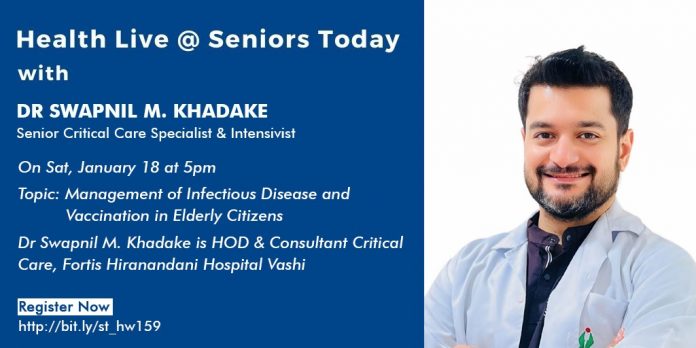On 18 Jan, 2025, Seniors Today hosted their weekly Health Live Webinar, Dr Swapnil M Khadake, HOD & Consultant Critical Care, Fortis Hiranandani Hospital Vashi who spoke on and answered questions about Management of Infectious Disease and Vaccination in the Elderly.
Dr Swapnil Madhav Khadake is a highly accomplished Chief Intensivist attached with Fortis Hiranandani Hospital Vashi. Dr. Swapnil holds MBBS, MD Anaesthesia, IDCCM, FCCCM, ECMO (M), CCD (Diabetes) BMJ-Royal College of Physicians. He is also a prolific author with numerous international publications.
His areas of expertise encompass Airway Management, Mechanical ventilation, Home Ventilation, cardiac output monitoring sedation and pain management, Enteral and Parenteral Nutrition, general and regional anesthesia, Continuous Renal Replacement Therapy (CRRT), Extra Corporeal Membrane Oxygenation (ECMO), and Management of Polytrauma. He has to his credit the foundation of the Nephrocritical Care Society in 2023.
Covid was a virus that put the immunocompromised and the paediatric age group in a vulnerable state. And the panic and stress related to the disease hindered the recovery.
Same is the case with the HMPV (Human Meta Pnemo Virus) which is also a viral disease.
Viruses are known for their notorious effects on multiple organs in the body, especially in an immunocompromised individual, or one with comorbidities or individuals with other co-existing respiratory disease, such as asthma or COPD.
We are better equipped for an epidemic as compared to the time when COVID has struck. This has been seen in the way cases were managed post COVID when there was a spread of chikinguniya an H1N1 virus and even some severe episodes of dengue spread.
Chronic epidemics such as tuberculosis and leprosy are also well controlled.
Ever since COVID there has been a rise in the level of preparedness and knowledge, healthcare and fitness.
The COVID virus was much more virulent than the presently spreading HMPV.
HMPV is not a new virus. It was identified in 2001 in the Netherlands while studying about unclassified respiratory infections.
Historical data suggest that when we proceed with retrospective testing it shows that HPMV existed even back in 1958, which means that it was circulating undetected for decades.
The HMPV is closely related to Avian Meta Virus, which means that it has zoonotic origin, i.e. it primarily affects animals.
Mode of transmission:
- Respiratory droplets through coughing and/ or sneezing
- Direct contact with an infected human/ contaminated surfaces
Viral shedding can last for 1- 2 weeks in a healthy individual and for longer in an immunocompromised individual.
These viruses are present in our environment but they do not always infect everybody. However, an immunocompromised individual is prone to infections by such a virus.
Epidemiological trend:
- Seasonal peaks
- Early Winters
Causes:
- Localised outbreaks
- Broad epidemics
Symptoms:
- Cough
- Nasal congestion
- Sore throat
- Fever
In many healthy individuals, it is a self limiting disease.
Severe cases can have symptoms such as:
- Bronchiolitis
- Pneumonia
- Wheezing
- Respiratory distress
- Cyanosis
- Hypoxia
Complications of the disease include:
- Acute respiratory failure
- Exacerbation of asthma or COPD
- Viral ARDS (Acute Respiratory Distress Syndrome)
- Multi organ dysfunction/ failure
- In severe, untreated cases, the individual may succumb to the illness; which makes it important to timely diagnose and treat the illness.
- Secondary bacterial infections such as Streptococcal and Pneumococcal bacteria
- Myocarditis
- Encephalitis
Diagnosis can be made by the clinical presentation of the patient and by performing laboratory investigations. The lab investigations are highly unspecific. And when the disease is suspected, the entire battery of tests should be done, including the RNA- RTPCR to diagnose the presence of this virus.
Other than the RTPCR,
- Rapid Antigen Detection Test can also be done for faster diagnosis, but it is less sensitive and may miss mild cases.
- Serology for retrospective studies
- Imaging such as chest X Ray, CT scan- for complicated and non typical presentation cases
Population at risk:
- Children
- Immunocompromised individuals- cancer patient, transplant patients, HIV/ AIDS, patients with chronic diseases
- Elderly population is at risk due to their weaning immunity and associated comorbidities
Treatment includes:
- Supportive therapy
- Oxygen therapy for hypoxemia
- Mechanical ventilation for respiratory failure
- IV fluids for dehydration- we need to also take care to avoid fluid overload in the lungs
- Corticosteroids- it is a double edged sword, it does reduce the infection but at the same time can also lead to immunosuppression thereby opening the window for another infection
Preventive strategies include:
- Frequent hand washing
- Wearing a mask when in a public/ crowded area
- Regular cleaning of highly touched surfaces
- Avoiding close contact with symptomatic patients
Reinfections are usually milder in form due to partial immunity.








